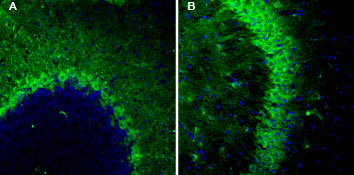Overview
- Peptide ETLQAFDSHYDYTVC, corresponding to amino acid residues 376-390 of rat TSHR (Accession P21463). Extracellular, N-terminus.

 Expression of TSH receptor in mouse brainImmunohistochemical staining of TSHR in mouse brain sections using Anti-TSH Receptor (TSHR) (extracellular)-ATTO Fluor-488 Antibody (#ATR-006-AG), (1:60). A. In the cerebellum, TSHR staining (green) appears in the molecular layer (MOL) and purkinje (P) layer. B. In the hippocampus, staining appears in CA3 pyramidal layer (P), (arrows). Nuclei are stained using DAPI (blue).
Expression of TSH receptor in mouse brainImmunohistochemical staining of TSHR in mouse brain sections using Anti-TSH Receptor (TSHR) (extracellular)-ATTO Fluor-488 Antibody (#ATR-006-AG), (1:60). A. In the cerebellum, TSHR staining (green) appears in the molecular layer (MOL) and purkinje (P) layer. B. In the hippocampus, staining appears in CA3 pyramidal layer (P), (arrows). Nuclei are stained using DAPI (blue).
- Klein, J.R. (2014) Front. Immunol. 7, 155.
- Vassart, G. and Dumont, J.E. (1992) Endocr. Rev. 13, 596.
- de Lloyd A. et al. (2010) J. Endocrinol. 204, 13.
- Davies, T. et al. (2002) J. Clin. Invest. 110, 161.
- Prabhakar, B.S. et al. (2003) Endocr. Rev. 24, 802.
Thyroid stimulating hormone (TSH), a glycoprotein hormone composed of α and β chains, is produced by thyrotrope cells of the anterior pituitary1. The TSH receptor (TSHR) plays a prominent role in thyroid physiology and disease. The established biological function of TSHR in the thyroid gland is to regulate synthesis and secretion of thyroid hormones from follicular thyroid cells; it also plays an important role in controlling the growth and development of the thyroid gland2.
TSHR is a G-protein coupled receptor and shares the classic structure of the serpentine receptor family (seven membrane spanning segments, an extracellular N-terminus and an intracellular carboxy terminal)3.
TSHR is primarily expressed in the epithelial cells of the thyroid follicles, but TSHR mRNA and protein have been detected in a variety of cell types including brain, testes, kidney, heart, bone, thymus, lymphocytes, adipose tissue and fibroblasts4.
Chronic stimulation of the TSHR leads to over activation of the cAMP pathway that in turn causes thyroid hyperplasia and hyperthyroidism. This process occurs in Graves' disease (GD) in which thyroid stimulating antibodies (TSAB) bind the receptor and mimic the action of TSH5.
Application key:
Species reactivity key:
Anti-TSH Receptor (TSHR) (extracellular) Antibody (#ATR-006) is a highly specific antibody directed against an epitope of the rat protein. The antibody can be used in western blot analysis. The antibody recognizes an extracellular epitope and thus is ideal for detecting the receptor in living cells. It has been designed to recognize TSHR from human, rat, and mouse samples.
Anti-TSH Receptor (TSHR) (extracellular)-ATTO Fluor-488 Antibody (#ATR-006-AG) is directly labeled with an ATTO-488 fluorescent dye. ATTO dyes are characterized by strong absorption (high extinction coefficient), high fluorescence quantum yield, and high photo-stability. The ATTO-488 label is analogous to the fluorescein isothiocyanate dye (FITC) and can be used with filters typically used to detect FITC. Anti-TSH Receptor (TSHR) (extracellular)-ATTO Fluor-488 Antibody has been tested in immunohistochemistry applications and is especially suited for experiments requiring simultaneous labeling of different markers.
